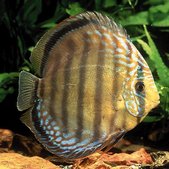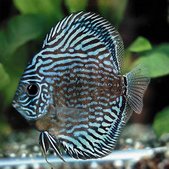Discus

Discus are among the most beautiful and most commonly kept species of cichlids. They belong to the genus Symphysodon, which essentially contains three species: the Heckel Discus (S. discus), the Green Discus (S. aequifasciatus), and the Blue and Brown Discus (S. haraldi). Blue and Brown Discus are no more than separate colour variants that occur together in the wild and mate with one another. In addition there are numerous cultivated forms of discus that can no longer be assigned to any of the wild species. Although discus are regarded as tricky aquarium fishes, whose successful maintenance and breeding requires a good knowledge of fish keeping, there are numerous fish farms in South-East Asia that specialise in discus and are able to breed any quantity required for the world market.
Important requirements
The natural habitat of discus is characterised by three features: the water is relatively warm (29-34°C); it is at least 1.5 metres deep; and the water is soft (no measurable hardness) and acid (pH 4-5). The delicacy of discus in the aquarium is primarily due to their poor resistance to pathogens of all types. While soft acid water is not essential for successful maintenance, an adequately high water temperature (at least 28 °C) and extremely high standards of hygiene are essential. The water temperature should not rise above 30°C, and 34 °C is often fatal. The necessary hygiene can be achieved using a large volume filter and regular large partial water changes. The filtration should be both mechanical and biological. The partial water changes should be made with conditioned fresh water; the temperature difference between the new water and the aquarium water should be no more than 2-4 °C and the new water should always be cooler, never warmer than the aquarium water.
Soft acid water limits the development of potentially harmful bacteria; anyone who decides to use this type of water for discus should always have a supply available for the essential partial water changes. To reinforce the immune response of the fishes the aquarium should always contain secondary plant material (primarily humic acids), provided by peat, Alder cones, or beech leaves, or special liquid preparations that are added at every water change.
As a rough rule of thumb the correct amount for partial water changes is 20-25% of tank volume weekly. Obviously the interval between water changes will depend on the aquarium size and the population density, and in the case of large, sparsely populated aquaria can be stretched out to every 2-3 weeks, while in heavily populated tanks water changes should be performed every 2-4 days.
Appropriate feeding
The correct feeding of discus is one of those subjects where 10 experts have 20 different opinions, and has been the subject of heated debate for decades. There are manufactured deep-frozen foods and special granulates for discus. Many successful breeders swear by beef heart, although the flesh of warm-blooded animals is fundamentally bad for fishes and difficult to digest properly.
Discus are by no means trophic specialists, but will eat any kind of ornamental fish food, i.e. frozen, manufactured, and live foods of suitable size. It is important that only top quality, highly digestible, raw materials are used in the manufacture of prepared foods. This will greatly reduce the pollution of the water by the metabolic wastes of the fishes, as a good quality, nutritious food will significantly lower the germ population in the aquarium water, as, obviously, excreted undigested food will be broken down by bacteria. It is generally best to feed small portions several times per day.
Well-fed discus can go without food for a few days without problem, for instance during holidays. If using an automated feeder it is important to refill it every day of possible, in order to avoid loss of quality in the food (breakdown of vitamins and unsaturated fatty acids) and prevent mildew.
The natural food of discus contains a relatively large percentage of decaying vegetable material (plant detritus). Hence for long-term good health small quantities of dead leaves (Sea Almond, Beech, Oak, Alder, Birch etc.) should always be available in the aquarium as supplementary foods. The secondary plant substances released by the dead leaves will serve as a prophylactic against disease.
Correct maintenance
Regular partial water changes and attention to water chemistry and quality (see above) are the most important maintenance measures.
Aquarium and tankmates
Discus grow to 15-20 cm across. They are not rapid swimmers, and usually glide quietly through their habitat. The minimum aquarium size for a pair can be regarded as 60 x 60 x 60 cm, and more fishes require correspondingly larger aquaria. The aquarium depth should if possible be no less than 50 cm, as otherwise the fishes may become nervous. The aquarium should provide plenty of cover (bogwood, large plants) and have a substrate of fine river sand (not builder’s sand!) at least in places, and the fishes will enjoy searching through this for food. Discus are cichlids, and pairs occupy breeding territories that they defend energetically against conspecifics and other fishes. Because these fishes always breed when kept correctly, this sort of behaviour should be taken into account.
Life expectancy
The oldest discus known was 17 years old. Discus often start to show signs of age after about five years of life. This can (on this occasion) be compared with longevity in humans. The maximum age of Homo sapiens is around 130 years; until the medicinal revolution average life expectancy was 30-40 years, but nowadays people in industrialised countries live for on average 70-80 years.
Size
Discus grow quickly initially and become sexually mature at the age of 9-12 months. At this point they will be half to two thirds of their eventual size. A discus should be full-grown at the age of 2-2.5 years.
Special details
Discus are gorgeous, majestic fishes that aren’t particularly delicate when kept properly. During their first days of life the young feed on skin secretions produced by the parents.



















